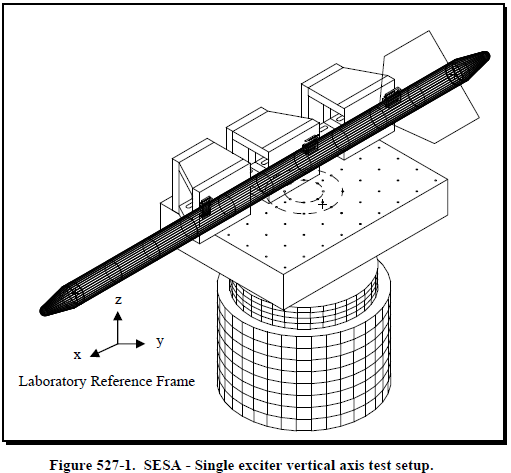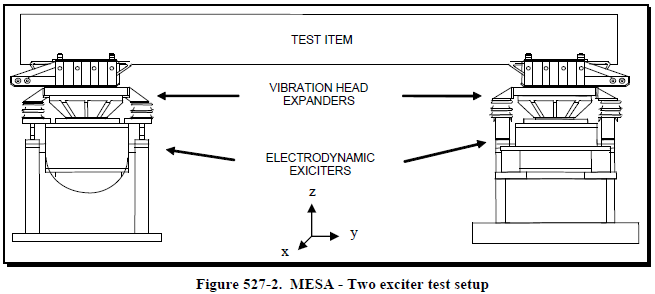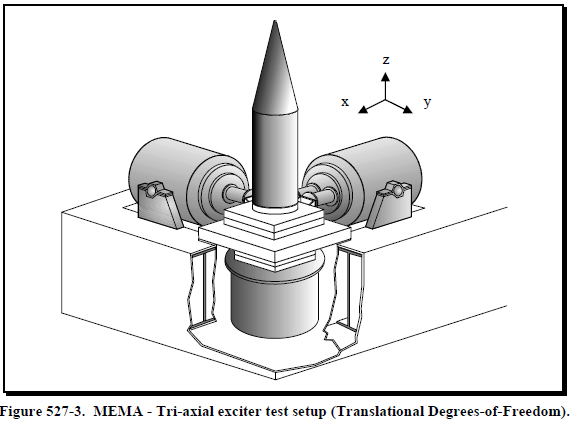- 2022-11-29 10:05:25

We will be putting Method 527 on the spotlight in this article. This method refers to TWR Method 525, Shock Method 516.6 and Electromechanical Vibration Method 514.6 which we previously covered in our blog. References are placed in the article where they are needed. It is advised to read our article and refer to the previous article for comprehensive knowledge upon subjects.
The term “exciter” refers to electro-mechanical shakers which are used in vibration and shock tests. There is more than one exciter used for one axis or more than one axes depending on the test configuration. Hence the name Multi-Exciter Testing (MET). This test method introduces us to many terminology and abbreviations. We thought a glossary of terms is needed before covering on subjects. The Method itself also contains this glossary in the standard.

Photo: Turkish Missile, “Tendürek”, mounted on SESA exciter at horizontal axis. Couplings are providing MDOF to test item. SIMO drive and measurement techniques are used. Photo from https://www.sage.tubitak.gov.tr/tr/haber/ex-proof-titresimsok-test-cihazi-tubitak-sagede-kullanimda
Terminology:
1. Single-Degree-of-Freedom (SDOF) – Motion defined by the movement of matter along or about a single axis. Only one coordinate is required to fully define the position of an object at any given time.
2. Multi-Degree-of-Freedom (MDOF) – Motion defined by specimen movement along or about multiple axes. More than one coordinate is required to fully define the position of the specimen at any given time.
3. Single-Axis (SA) - Excitation or response measurement in a unique single vector orientation (linear or rotational). The vector direction of the axis of rotation is perpendicular to the plane of rotation of the shaker or specimen. Figure 527-1 shows a vertical single-axis input to the expansion structure.
4. Multi-Axis (MA) – excitation or response measurement that requires more than one unique vector for description. Refer to Figures 527-2 and 527-3 for MA examples of both two-axis and three-axis inputs to a common structure.
5. Single-Input/Single-Output (SISO) - refers to the input of a single drive signal to the excitation system in the SDOF configuration and a measured output from the device or test item in the SDOF configuration.
6. Single-Input/Multiple-Output (SIMO) - refers to the input of a single drive signal to the excitation system in the SDOF configuration and multiple measured outputs from the device or test item in the MDOF configuration. In general, for spec purposes, the dynamic behavior of the test item will not be assumed to contribute to the output DOF, i.e. the measured rotation of the excited extended test item in cantilever mode will essentially always be treated as a SET with a characteristic acceleration linearity for the output.
7. Multiple-Input/Single-Output (MISO) - refers to the input of a multiple drive signals to an exciter system configuration in a MDOF configuration and a single measured output from the fixture or test item in a SDOF configuration. This terminology is most used in measurement data processing where the single output is a composite of measurements from multiple inputs.
8. Multiple-Input/Multiple-Output (MIMO) - refers to the input of a multiple drive signals to an exciter system configuration in a MDOF configuration, and the multiple measured outputs from the fixture or test item in a MDOF configuration. It is important to note that generally there is no one-to-one correspondence between inputs and outputs, and the number of inputs and the number of outputs may be different.
9. Single-Exciter/Single-Axis (SESA) - application of a single exciter providing dynamic input to the test item in a single vector direction.

10. Multi-Exciter/Single-Axis (MESA) – application of multiple exciters providing dynamic input to the test item in a single vector direction. For example, extended materiel might require excitation at the forward and aft end in a single vector axis as illustrated in Figure 527-2. For the case in which the two exciters are driven to a common specification with respect to both phase and amplitude, the output may be described basically in the one axis of excitation. For the case in which the two exciters are driven to independent magnitude and/or phase specifications, the output may need to be described in terms of a forward axis and aft axis and, perhaps, a rotational axis about the test item’s center-of-gravity (CG).
Figure 527-2 illustrates a two-exciter application. Note that the system would require appropriate bearing assemblies to allow a pure rotational MESA or combined linear and rotational MEMA motion.

11. Multi-Exciter/Multi-Axis (MEMA) - Application of multiple exciters providing dynamic input to the test item in a way that requires more than a single vector for complete description of excitation and measurement. Figure 527-3 displays a three exciter three axis test. Three axes vertical, transverse, and longitudinal are required to describe the test. Note that many multi-axis test platform configurations have been built in recent years. Common 6 exciter examples are the hexapod (Stewart Platform), MAST, and Team Cube. There are also over-determined actuated systems consisting of more than 6 exciters. In each case, the dynamic properties vary between designs and must be considered in the design of a MET.

Procedure(s):
Once you have selected the test item configuration which applicable to you, you may proceed to selecting the proper test procedure. The reason we used the word "applicable" is there may be difference depending on configurations which some maybe not be applicable in your situation. In particular, determine if carefully measured and properly processed hardware field measurement configuration information is available in the form of band-limited time history or automatic, cross-sectional spectral density estimates, where appropriate, to be consistent with the laboratory's MET and vibration configuration requires the control system of the vendor's software specifications. Basic considerations are made for single-axis environments requiring multiple exciters or multi-axis environments requiring multiple exciters. There are 2 procedures in this method.
a. Procedure I – Time Domain Reference Criteria This MET Procedure is an extension to the SESA Time Waveform Replication (TWR) techniques addressed in Method 525. As is the case for the SESA case, the time histories synthesized for a MEMA TWR test are not limited to stationary Gaussian structures.
You may refer our previous article for Method 525 from here: https://pals.com.tr/blog/mil-std-810g-test-method-525-time-waveform-replication
b. Procedure II – Frequency Domain Reference Criteria This MET Procedure is an extension to the SESA spectral-based vibration control techniques addressed in Method 514.6. As is the case for the SESA case, the time histories synthesized for a MEMA random test will be stationary and Gaussian in structure.
You may refer our previous article for Method 514.6 from here: https://pals.com.tr/blog/mil-std-810g-test-method-5146-vibration
Effects of the MET Environment.:
We suggest referring relevant test method’s article, which applicable for your test item, for tips and tricks. In terms of general idea of the effects of MET environment are presented below.
1. Fatigue, cracking and rupture sensitive to multi-axis excitation
2. Deformation of materiel structure, e.g., protruding parts
3. Loosening of seals and connection.
4. Displacement of components
5. Chafing of surfaces with single-axis design
6. Contact, short-circuiting or degradation of electrical components
7. Misalignment of materiel components (e.g., optical)
DID YOU KNOW?
PALS Electronics has experts on all subjects of test engineering, mechanical or electronic design, environmental condition engineer, system engineer etc. PALS provides consulting, training, tailoring, test plan, test engineering, test services in all phases of your project. Please feel free if you have any questions or inquiries from https://pals.com.tr/contact










